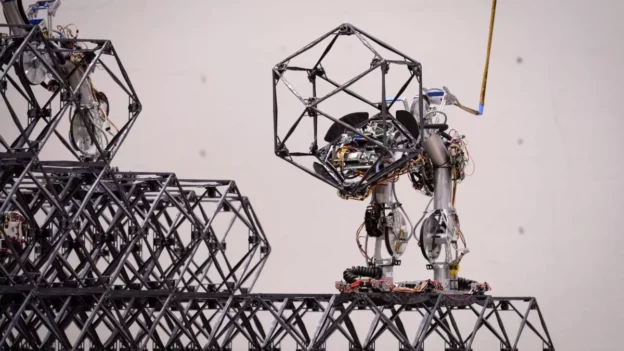NASA is advancing its goal of establishing permanent settlements on the Moon through a successful test of autonomous construction robots .
NASA’s Automated Reconfigurable Mission Adaptive Digital Assembly Systems team, specializing in autonomous construction technology, successfully conducted a test at the Ames Research Center in Santa Clara County, California in which three robots were able to build a shelter structure on a meter scale equivalent to the size of a shed, using hundreds of building blocks.
The robots used building blocks known as voxels , which are volumetric pixels capable of configuring virtually any structure, the agency said. Conceptual images were presented illustrating how these blocks can be transformed into frames for solar panels on the Moon, stabilizing pillars for advanced cave stations and as support for ejecta or debris shields on landing platforms.
Although the ARMADAS team provided the structural plans to the robots, they stressed that they did not micromanage the robots’ work, letting the software algorithms plan the tasks autonomously. The test demonstrated an essential capability of the programs: practicing the construction sequence in simulation before carrying out the actual execution.
Although NASA did not provide detailed information on the robots’ possible terrestrial applications, it emphasized the potential of these machines for building large-scale infrastructure , such as solar power stations , communication towers, and habitats on both the Moon and the Earth. Mars.
In addition, he highlighted the ability of robots to erect structures before the arrival of humans. The team’s results were published in the journal Science Robotics . The voxels are manipulated by robots known as Omnidirectional Lattice Locomotion Climbing Explorers (SOLL-E), capable of climbing and maneuvering around the voxels, even when they are stacked on top of each other.
“In general, it is very difficult to develop robust autonomous robots that can operate in unstructured environments, such as a typical construction site.“Christine Gregg, ARMADAS chief engineer at NASA Ames, said in the statement. “We turn that problem on its head by creating very simple and reliable robots that operate in an extremely structured lattice environment.”.
How do autonomous construction robots operate?
In the test, two robots moved along the outside of the structure, manipulating one voxel with each movement. One of them was responsible for collecting the materials before transferring them to the second robot for placement. A third robot followed the process, scaling within the set of voxels and assembling them.
“Making large structures from small building blocks allows us to use good materials at the lowest cost“Kenny Cheung, ARMADAS principal investigator at NASA Ames, said in the statement. “The size of structures that can be built is only limited by the number of building blocks that can be supplied”.
Notably, NASA considers autonomous construction as a key strategy ahead of the next manned mission to lunar orbit scheduled for 2025, as part of its Artemis initiative, which aims to return humans to the Moon in 2026. In February of last year, the agency allocated $6 million in funding for academic institutions to research technologies that would facilitate the creation of a permanent lunar settlement, including autonomous construction.
Don’t miss any of our posts and follow us on social media!
Inspenet.com YouTube LinkedIn Facebook Instagram
Source: constructiondive.com

